高一英语下学期unit18-New-Zealand
- 格式:pdf
- 大小:1.12 MB
- 文档页数:9


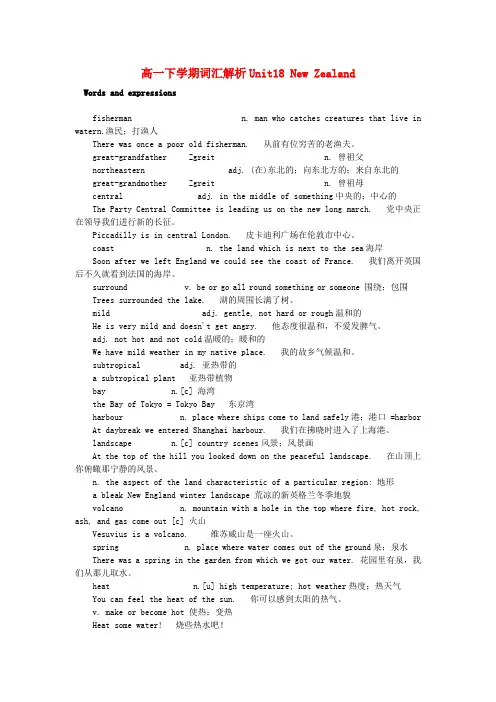
高一下学期词汇解析Unit18 New ZealandWords and expressionsfisherman n. man who catches creatures that live in watern.渔民;打渔人There was once a poor old fisherman. 从前有位穷苦的老渔夫。
great-grandfather Zgreit n. 曾祖父northeastern adj. (在)东北的;向东北方的;来自东北的great-grandmother Zgreit n. 曾祖母central adj. in the middle of something中央的;中心的The Party Central Committee is leading us on the new long march. 党中央正在领导我们进行新的长征。
Piccadilly is in central London. 皮卡迪利广场在伦敦市中心。
coast n. the land which is next to the sea海岸Soon after we left England we could see the coast of France. 我们离开英国后不久就看到法国的海岸。
surround v. be or go all round something or someone 围绕;包围Trees surrounded the lake. 湖的周围长满了树。
mild adj. gentle, not hard or rough温和的He is very mild and doesn't get angry. 他态度很温和,不爱发脾气。
adj. not hot and not cold温暖的;暖和的We have mild weather in my native place. 我的故乡气候温和。


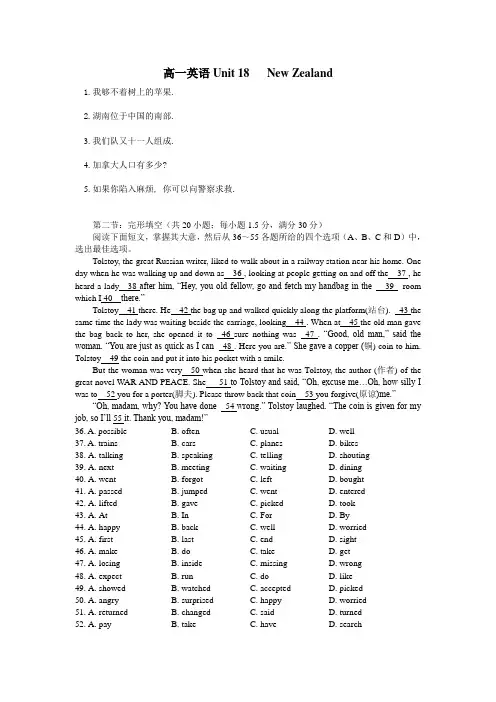
高一英语Unit 18 New Zealand1.我够不着树上的苹果.2.湖南位于中国的南部.3.我们队又十一人组成.4.加拿大人口有多少?5.如果你陷入麻烦, 你可以向警察求救.第二节:完形填空(共20小题;每小题1.5分,满分30分)阅读下面短文,掌握其大意,然后从36~55各题所给的四个选项(A、B、C和D)中,选出最佳选项。
Tolstoy, the great Russian writer, liked to walk about in a railway station near his home. One day when he was walking up and down as 36 , looking at people getting on and off the 37 , he heard a lady 38 after him, “Hey, you old fellow, go and fetch my handbag in the 39 room which I 40 there.”Tolstoy 41 there. He 42 the bag up and walked quickly along the platform(站台). 43 the same time the lady was waiting beside the carriage, looking 44 . When at 45 the old man gave the bag back to her, she opened it to 46 sure nothing was 47 . “Good, old man,” said the woman. “You are just as quick as I can 48 . Here you ar e.” She gave a copper (铜) coin to him. Tolstoy 49 the coin and put it into his pocket with a smile.But the woman was very 50 when she heard that he was Tolstoy, the author (作者) of the great novel WAR AND PEACE. She 51 to Tolstoy and said, “Oh, excuse me…Oh, how silly I was to 52 you for a porter(脚夫). Please throw back that coin 53 you forgive(原谅)me.”“Oh, madam, why? You have done 54 wrong.” Tolstoy laughed. “The coin is given for my job, so I’ll 55 it. Thank you, madam!”36. A. possible B. often C. usual D. well37. A. trains B. cars C. planes D. bikes38. A. talking B. speaking C. telling D. shouting39. A. next B. meeting C. waiting D. dining40. A. went B. forgot C. left D. bought41. A. passed B. jumped C. went D. entered42. A. lifted B. gave C. picked D. took43. A. At B. In C. For D. By44. A. happy B. back C. well D. worried45. A. first B. last C. end D. sight46. A. make B. do C. take D. get47. A. losing B. inside C. missing D. wrong48. A. expect B. run C. do D. like49. A. showed B. watched C. accepted D. picked50. A. angry B. surprised C. happy D. worried51. A. returned B. changed C. said D. turned52. A. pay B. take C. have D. search53. A. unless B. if C. because D. until54. A. something B. everything C. anything D. nothing55. A. throw B. remain C. keep D. stay第三部分:阅读理解(共20小题;每小题2分,满分40分)阅读下列短文,从每题所给的四个选项(A、B、C和D)中,选出最佳选项。

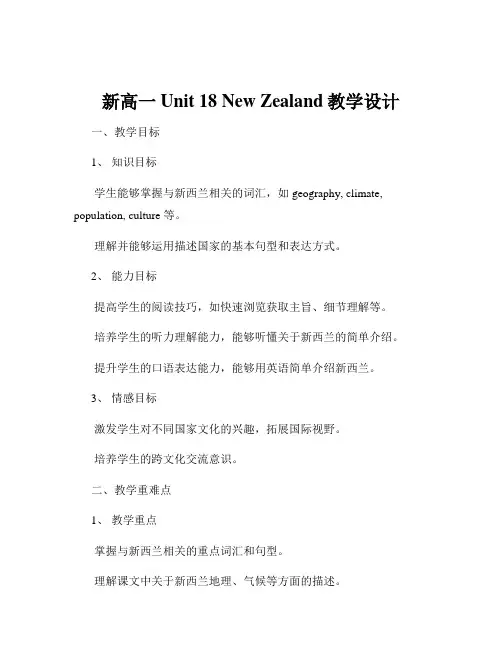
新高一Unit 18 New Zealand教学设计一、教学目标1、知识目标学生能够掌握与新西兰相关的词汇,如 geography, climate, population, culture 等。
理解并能够运用描述国家的基本句型和表达方式。
2、能力目标提高学生的阅读技巧,如快速浏览获取主旨、细节理解等。
培养学生的听力理解能力,能够听懂关于新西兰的简单介绍。
提升学生的口语表达能力,能够用英语简单介绍新西兰。
3、情感目标激发学生对不同国家文化的兴趣,拓展国际视野。
培养学生的跨文化交流意识。
二、教学重难点1、教学重点掌握与新西兰相关的重点词汇和句型。
理解课文中关于新西兰地理、气候等方面的描述。
2、教学难点能够运用所学知识,用英语流利地介绍新西兰。
对新西兰文化的理解和跨文化交流意识的培养。
三、教学方法1、任务驱动教学法通过布置各种任务,让学生在完成任务的过程中学习和运用知识。
2、情景教学法创设与新西兰相关的情景,让学生在情景中感受和理解。
3、合作学习法组织学生进行小组合作学习,共同探讨问题,培养合作能力。
四、教学过程1、导入(5 分钟)展示一张新西兰的美丽风景图片,问学生:“Do you know where this is?” 引发学生的兴趣。
播放一段关于新西兰的简短视频,让学生对新西兰有一个初步的印象。
2、词汇学习(10 分钟)展示与新西兰相关的词汇,如 mountains, lakes, beaches, Maori 等,通过图片、例句等方式帮助学生理解和记忆。
进行简单的词汇练习,如单词拼写、英汉互译等。
3、阅读课文(15 分钟)让学生快速阅读课文,回答问题:What is the main idea of the passage?仔细阅读课文,完成表格,内容包括新西兰的地理位置、气候、人口、主要城市等。
4、听力训练(10 分钟)播放一段关于新西兰的听力材料,让学生回答问题,如:What is the climate like in New Zealand?再次播放听力材料,让学生跟读,模仿语音语调。

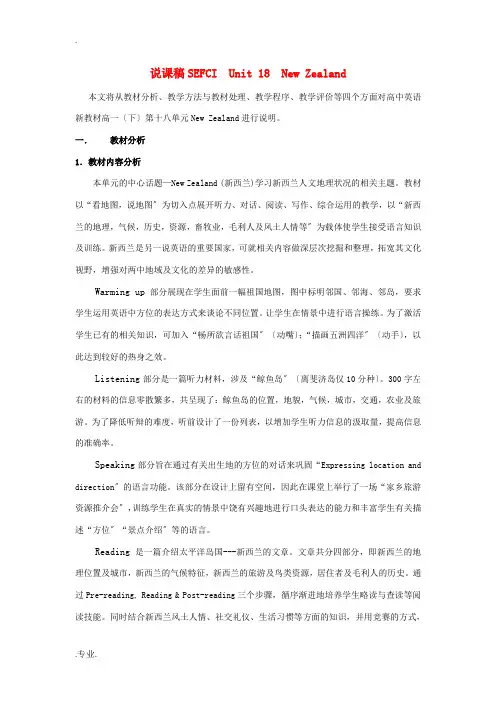
说课稿SEFCI Unit 18 New Zealand 本文将从教材分析、教学方法与教材处理、教学程序、教学评价等四个方面对高中英语新教材高一〔下〕第十八单元New Zealand进行说明。
一.教材分析1.教材内容分析本单元的中心话题—New Zealand (新西兰)学习新西兰人文地理状况的相关主题。
教材以“看地图,说地图〞为切入点展开听力、对话、阅读、写作、综合运用的教学,以“新西兰的地理,气候,历史,资源,畜牧业,毛利人及风土人情等〞为载体使学生接受语言知识及训练。
新西兰是另一说英语的重要国家,可就相关内容做深层次挖掘和整理,拓宽其文化视野,增强对两中地域及文化的差异的敏感性。
Warming up部分展现在学生面前一幅祖国地图,图中标明邻国、邻海、邻岛,要求学生运用英语中方位的表达方式来谈论不同位置。
让学生在情景中进行语言操练。
为了激活学生已有的相关知识,可加入“畅所欲言话祖国〞〔动嘴〕;“描画五洲四洋〞〔动手〕,以此达到较好的热身之效。
Listening部分是一篇听力材料,涉及“鲸鱼岛〞〔离斐济岛仅10分种〕。
300字左右的材料的信息零散繁多,共呈现了:鲸鱼岛的位置,地貌,气候,城市,交通,农业及旅游。
为了降低听辩的难度,听前设计了一份列表,以增加学生听力信息的汲取量,提高信息的准确率。
Speaking部分旨在通过有关出生地的方位的对话来巩固“Expressing location and direction〞的语言功能。
该部分在设计上留有空间,因此在课堂上举行了一场“家乡旅游资源推介会〞,训练学生在真实的情景中饶有兴趣地进行口头表达的能力和丰富学生有关描述“方位〞“景点介绍〞等的语言。
Reading是一篇介绍太平洋岛国---新西兰的文章。
文章共分四部分,即新西兰的地理位置及城市,新西兰的气候特征,新西兰的旅游及鸟类资源,居住者及毛利人的历史。
通过Pre-reading, Reading & Post-reading三个步骤,循序渐进地培养学生略读与查读等阅读技能。
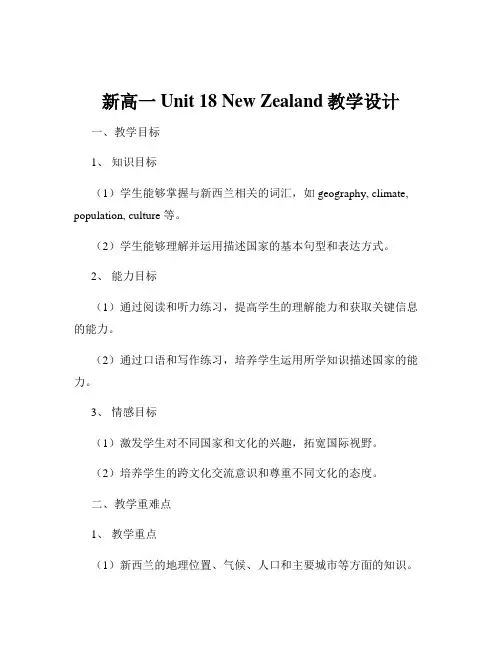
新高一Unit 18 New Zealand教学设计一、教学目标1、知识目标(1)学生能够掌握与新西兰相关的词汇,如 geography, climate, population, culture 等。
(2)学生能够理解并运用描述国家的基本句型和表达方式。
2、能力目标(1)通过阅读和听力练习,提高学生的理解能力和获取关键信息的能力。
(2)通过口语和写作练习,培养学生运用所学知识描述国家的能力。
3、情感目标(1)激发学生对不同国家和文化的兴趣,拓宽国际视野。
(2)培养学生的跨文化交流意识和尊重不同文化的态度。
二、教学重难点1、教学重点(1)新西兰的地理位置、气候、人口和主要城市等方面的知识。
(2)相关词汇和句型的掌握及运用。
2、教学难点(1)如何引导学生准确、流畅地用英语描述新西兰的特点。
(2)培养学生对不同文化的理解和包容。
三、教学方法1、情景教学法通过创设与新西兰相关的情景,让学生在真实的语境中学习和运用语言。
2、任务驱动法布置各种任务,如小组讨论、写作、角色扮演等,激发学生的学习积极性和主动性。
3、多媒体教学法运用图片、视频等多媒体资源,增强教学的直观性和趣味性。
四、教学过程1、导入(5 分钟)(1)展示一张世界地图,提问学生是否知道新西兰在地图上的位置。
(2)播放一段关于新西兰自然风光的视频,引起学生的兴趣。
2、词汇学习(10 分钟)(1)通过图片和简单的英文解释,教授与新西兰相关的新词汇,如 island, mountains, beaches 等。
(2)进行词汇练习,如单词拼写、配对等,巩固所学词汇。
3、阅读与理解(15 分钟)(1)分发一篇关于新西兰的短文,让学生快速阅读,找出文章的主旨大意。
(2)再次仔细阅读,回答一些细节问题,如新西兰的气候特点、主要城市等。
4、听力练习(10 分钟)播放一段关于新西兰的听力材料,让学生完成听力填空或选择练习,进一步强化对相关知识的理解。
5、小组讨论(10 分钟)(1)将学生分成小组,讨论以下问题:What do you think is themost attractive aspect of New Zealand? Why?(2)每组推选一名代表进行发言,分享小组讨论的结果。
新高一Unit 18 New Zealand教学设计(精选2篇)
新高一Unit 18 New Zealand 篇1
内容预览:
Period 2(一) 明确目标1. T o know something about New Zealand.2. To train the abilities of skimming and scanning the text.3. To study the language points in relation to the text.(二)整体感知Step 1 PresentationToday we are going t……
你还没注册?或者没有登录?这篇文章要求至少是本站的注册用户才能阅读!
如果你还没注册,请赶紧点此注册吧!
如果你已经注册但还没登录,请赶紧点此登录吧!
新高一Unit 18 New Zealand教学设计篇2
内容预览:
Period 1 (一)明确目标1. Learn the useful expressions to talk about location and direction.2. Have listening practice.(二)整体感知Step 1Show the students a map of china and ask them to find out several plac……
你还没注册?或者没有登录?这篇文章要求至少是本站的注册用户才能阅读!
如果你还没注册,请赶紧点此注册吧!
如果你已经注册但还没登录,请赶紧点此登录吧!。
高一英语下册 Unit18 New Zealand(备课资料)教案大纲人教版第一册一、异域风情1.Way of LifeNew Zealand is an independent nation and a member of the British Commonwealth(英联邦).The majority of New Zealanders are of British descent,and the largest minority is New Zealand's indigenous Maori who make up around 14 percent of the population.New Zealand lives in burgalows(带走廊的平房),singlestory,single-unit dwellings(住处)on small lots(地).Highrise residential(住宅的)development is a recent phenomenon confined(局限于)mainly to Auckland and Wellington.Most New Zealand families have a vegetable and fruit garden on their lot where they grow some of their food.It is common for families to have animals as pets,especially cats and dogs.New Zealanders are keen sport participants and followers,Primary winter sports are rugby,soccer,hocky,netball(avariant of basketball,played by women),skating,skiing,and mountain climbing.The most popular summer sports are cricket(板球),tennis,swimming and sailing.2.New Zealand—Land of the White CloudWith its primeval forests,mighty snowcapped peaks,gigantic jords and grumbling volcanoes,it's no wonder the makers of The Lord Of The Rings films decided to shoot the trilogy in New Zealand.Rugged ranger-types can relive .The Fellowship Of The Rings by scaling forbidding mountain passes or crossing volcanic moonscapes towards the cracks of doom.For more adrenaline highs there's an unbeatable choice of good value activities,form white water rafting and jet boat rides to bungee-jumping and skydiving.For more homely Hobbit types,NZ has many other attractions to enjoy—rambling countryside,a glorious coastline and plenty of sedate places to sit and enjoy the amazing views.And then there's the terrific cuisine and wine.With two weeks or more,a good way to see the country is to start in Auckland on the North Island,then drive to Wellington,crossing by ferry to the South Island.Take in the breathtaking scenery around Queenstown before flying home from Christchurch.There's too much to see beyond Auckland to justify spending too much time in the city,so head south to Waitomo.Hiding beneath this hilly area are the haunting Waitomo Glowworm Caves.Drift in silence in the dark on the subterranean lake and gaze up at the spectacular living lightshow.Adventure company Waitomo Luminosa leads groups through the underground rivers riding dark rapids on inner tyres.二、知识归纳(一)settle的用法1.作及物/不及物动词,“前往居住(与in连用)”(go to and live in);“定居、安家(与in,at 等连用)”(make one's home in/at…)。